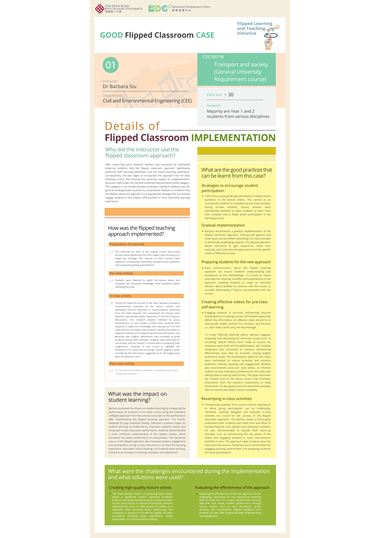
General Information
- Instructor: Dr Barbara W.Y. SIU
- Department: Department of Civil and Environmental Engineering
- Subject: CSE1B01W Transport and Society (General University Requirement course)
- Class Size: ~30
- Students: Majority are Year 1 and 2 students from various disciplines
Why Use the Flipped Classroom Approach?
Implementation Steps
Preparation of materials
The materials for each of the original 2-hour face-to-face lectures were segmented into short videos, each focusing on a single key message. The majority of these concise video segments incorporated interactive multiple-choice questions with automatic grading and feedback.
Pre-class activity
Students were required to watch the lecture videos and complete the interactive knowledge check questions before attending the class.
In-class activity
During the initial 30 minutes of the class, Barbara provided a comprehensive summary of the lecture content and addressed common questions or misconceptions stemming from the video lectures. The subsequent 60 minutes were devoted to group tasks (peer instruction) in the form of group discussions, mini research projects followed by group presentations, or case studies. In these tasks, students were required to apply the knowledge they had gained from the video lectures to analyse new situations, develop the ability to organise, evaluate, and integrate old and new information, and generate new insights. Worksheets were provided to guide students during these activities. Students were permitted to use AI tools, such as ChatGPT, to assist them in preparing their assignments. However, it was crucial to highlight the limitations of AI tools and encourage critical judgment when considering the information suggested by AI. All assignments were completed in class.
Post-class activity
To minimise the student’s workload, no additional post-class activity was required.
What Impact Did This Have on Student Learning?
What Are the Good Practices That Can Be Learnt from This Case?
Strategies to encourage student participation
10% of the course grade was allocated to multiple-choice questions in the lecture videos. This served as an incentive for students to complete the pre-class activities. During in-class activities, correct answers were intentionally withheld to allow students to learn from their mistakes and to foster active participation in the learning process.
Gradual implementation
Barbara recommends a gradual implementation of the flipped classroom approach, starting with general and lower-level courses before extending it to more complex or technically challenging subjects. This phased approach allows instructors to gain experience, refine their methods, and customise the approach to suit the specific needs of different courses.
Preparing students for the new approach
Early communication about the flipped teaching approach can ensure students' understanding and acceptance of the methodology. It's crucial to clearly articulate the rationale, benefits, and expectations of the approach, enabling students to make an informed decision about whether to continue with the course or consider withdrawing if they're uncomfortable with the format.
Creating effective videos for pre-class self-learning
Engaging students in pre-class self-learning requires investing time in creating concise, informative videos that deliver key information. An effective video should be of appropriate length (around 5-6 minutes), and focused, i.e., each video covers only one key message.
To create effective teaching videos, Barbara suggests preparing and rehearsing full voice-over scripts prior to recording. Special efforts were made to ensure the sentences were brief and straightforward, and complex vocabulary was minimised to enhance self-learning effectiveness and cater to students' varying English proficiency levels. The presentation slides for the video were overhauled to reduce verbosity and enhance aesthetics, thereby boosting user engagement. Barbara also recommends voice-over style videos, as informal student surveys indicated a preference for this style over talking-head or side-by-side formats. This style maximises the content area on the device screen and minimises distractions from the teacher's expressions or body movements. It's also good practice to avoid time-sensitive data to enhance the videos' future reusability.
Revamping in-class activities
Transitioning students from passive lecture attendance to active group participation can be challenging. Therefore, carefully designed and executed in-class activities are crucial for the success of the flipped classroom approach. The teacher needs to thoroughly understand their students and invest time and effort in transforming the class delivery into interactive activities. It's also recommended to include brief warm-up activities, such as summarizing the key points of the videos and engaging students in quick mini-research activities in class. This approach helps students ease into interactive discussions, fostering a more comfortable and engaging learning environment and preparing students for active participation.
What Were the Challenges Encountered During the Implementation and What Solutions Were Used?
The time-intensive nature of producing these videos posed a significant concern regarding workload. However, this issue was alleviated by reusing the videos for the same course in subsequent iterations. Barbara addressed the issue of video quality by setting up a dedicated video recording studio. Additionally, she employed an assistant to handle the logistics of video production, including script organisation, studio preparation, and post-production editing.
Evaluating the effectiveness of the approach
Assessing the effectiveness of the new approach can be challenging, particularly for less experienced teaching staff. To tackle this, it's crucial to establish clear learning objectives and assess student performance through various means, such as class discussions, group activities, and examinations. Regular feedback from students can also offer insights into their understanding and engagement.

